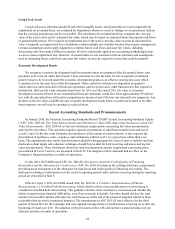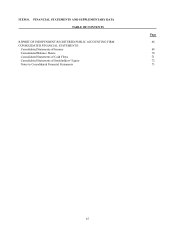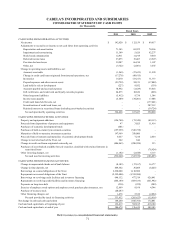Cabela's 2011 Annual Report Download - page 72
Download and view the complete annual report
Please find page 72 of the 2011 Cabela's annual report below. You can navigate through the pages in the report by either clicking on the pages listed below, or by using the keyword search tool below to find specific information within the annual report.
62
The following table provides summary information concerning other commercial commitments at
December 31, 2011:
(In Thousands)
Letters of credit (1) $ 9,686
Standby letters of credit (1) 5,006
Revolving line of credit for boat and ATV inventory (2) 524
Open account document instructions 40,074
Bank – federal funds (3) -
Secured variable funding obligations of the Trust (4) 460,000
Tot al $ 515,290
(1) Our credit agreement allows for maximum borrowings of $415 million including lender letters of credit and
standby letters of credit. At December 31, 2011, the total amount of borrowings under this revolving line of
credit was $15 million, which consisted of lender letters of credit and standby letters of credit. Our credit
agreement for operations in Canada is for $15 million CAD, of which all was available for borrowing at
December 31, 2011.
(2) The line of credit for boat and all-terrain vehicles financing is limited by the aforementioned $415 million
revolving line of credit to $100 million of secured collateral.
(3) The maximum amount that can be borrowed on the federal funds agreements is $85 million.
(4) The maximum amount that can be borrowed from third party investors on the variable funding facilities is
$875 million.
Off-Balance Sheet Arrangements
Operating Leases – We lease various items of office equipment and buildings. Rent expense for these
operating leases is recorded in selling, distribution, and administrative expenses in the consolidated statements of
income. Future obligations are shown in the preceding contractual obligations table.
Credit Card Limits – WFB bears off-balance sheet risk in the normal course of its business. One form
of this risk is through WFB’s commitment to extend credit to cardholders up to the maximum amount of their
credit limits. The aggregate of such potential funding requirements totaled $20 billion above existing balances at
December 31, 2011. These funding obligations are not included in our consolidated balance sheet. While WFB has
not experienced, and does not anticipate that it will experience, a significant draw down of unfunded credit lines by
its cardholders, such an event would create a cash need at WFB which likely could not be met by our available cash
and funding sources. WFB has the right to reduce or cancel these available lines of credit at any time.
Critical Accounting Policies and Use of Estimates
Our consolidated financial statements have been prepared in accordance with accounting principles generally
accepted in the United States of America which requires management to make estimates and judgments that
affect amounts reported in the consolidated financial statements and accompanying notes. Management has
discussed the development, selection, and disclosure of critical accounting policies and estimates with the Audit
Committee of Cabela’s Board of Directors. While our estimates and assumptions are based on our knowledge of
current events and actions we may undertake in the future, actual results may ultimately differ from our estimates
and assumptions. Our estimation processes contain uncertainties because they require management to make
assumptions and apply judgment to make these estimates. Should actual results be different than our estimates, we
could be exposed to gains or losses from differences that may be material.
























